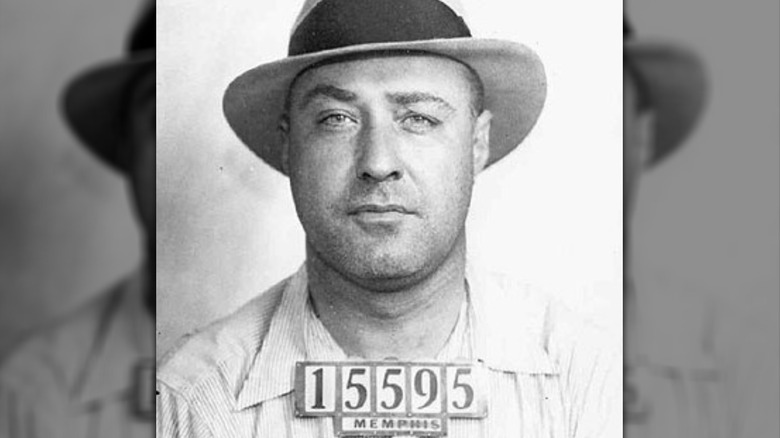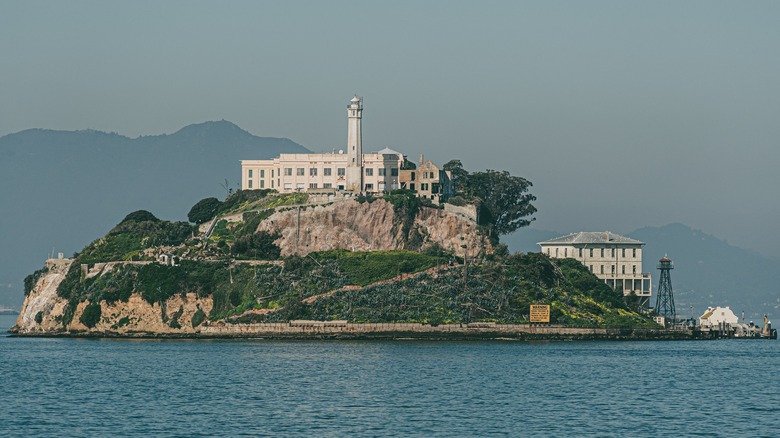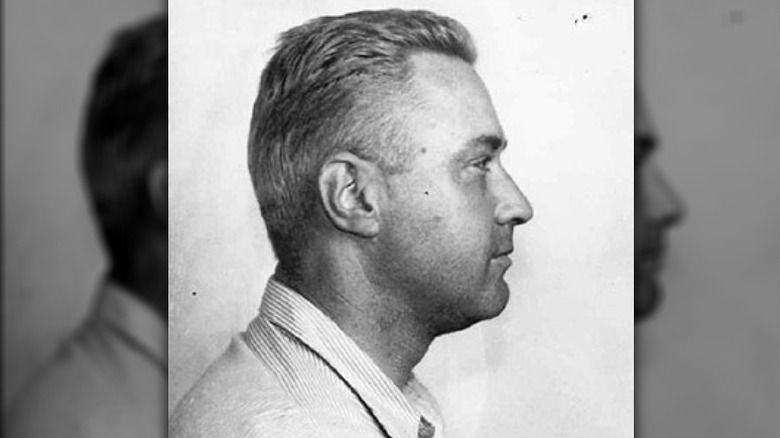What Machine Gun Kelly's Life In Prison Was Really Like
The infamous Machine Gun Kelly was a man whose reputation truly preceded him. According to All That's Interesting, there's no doubt that Kelly was a criminal. But a killer? Not so much. Born in 1895, George Kelly Barnes was a bootlegger who did a stint in prison after being caught selling illegal liquor (via Biography). Prior to his criminal career, Alcatraz East writes, he was raised in a well-to-do family from Memphis, Tennessee. Kelly was even a student at Mississippi State University before dropping out to marry his first wife.
While he was locked up, he befriended bank robbers who taught him the ropes (per All That's Interesting). When he was released in 1930, Biography states that Kelly married his girlfriend, Kathryn Thorne. She not only encouraged his criminal career but created Kelly's reputation. It's believed she bought him his first machine gun and gave him the nickname George "Machine Gun" Kelly. Per Showbiz CheatSheet, he went from committing a string of robberies to kidnapping. In 1933, Kelly abducted wealthy oil tycoon Charles Urschel from his Oklahoma City home.
Days later, Urschel was released after Kelly was given the $200,000 ransom he demanded (per Alcatraz History). However, this was the beginning of the end for Kelly's criminal career. Serial numbers on the bills given in the ransom, along with Urschel's testimony and a tip to the FBI, led them straight to Kelly and Thorne. After a week-long manhunt, Kelly and Thorne were found in Tennessee. Both were convicted and sentenced to life in prison.
He was transferred to Alcatraz
Kelly was first sent to Leavenworth Prison in Kansas. As Alcatraz History explains, he was quite familiar with this institution; Kelly had previously served time there for bootlegging back in 1928. However, his time in Leavenworth was short-lived. Kelly, ever the talker, defiantly told guards that he was planning to escape from Leavenworth and travel to Cincinnati to break out Thorne from prison. Naturally, prison officials did not take kindly to these threats and in 1934, it was decided that Kelly was to be transferred to Alcatraz. The New York Times writes that in September of that year, a train transported Kelly and other prisoners to San Francisco.
Per City Experiences, Kelly, who was then 39, arrived with 106 fellow inmates from Leavenworth. History points out that Alcatraz had only opened its doors weeks before their transfer. The prison was purportedly designed to instill fear in criminals like Kelly, who were revered and had gained notoriety for their many crimes. Additionally, government officials hoped that Alcatraz would deter those who were thinking about becoming criminals for the purpose of fame and glory.
Alcatraz, after all, was a secluded island that was said to be inescapable (via Sword and Scale). Despite boasting about his crimes at Alcatraz, City Experiences writes that those who got to know Kelly saw another side of him. Willie Radkay, a fellow inmate, whose cell was next to Kelly's, said that he was a "deeply reflective and intelligent man who was well-liked by most of the population."
Machine Gun Kelly's time at Alcatraz
At Alcatraz, Kelly was referred to as prisoner #117 (via City Experiences). All That's Interesting writes that his fellow inmates called him "Pop Gun Kelly." Clearly, they didn't seem to take him too seriously. While some prisoners at Alcatraz praised him, others felt like Kelly did not fit in with his surroundings. They also noted that after one of his companions died, prison life seemed to take a toll on him. Even so, Kelly was a model inmate, per Alcatraz History. He worked in the laundry and became an altar boy at the prison chapel. He played bridge on the weekends and often read. At one point, Kelly also had an office job at the prison.
SF Tourism Tips states that life at Alcatraz, however, was incredibly hard. This undoubtedly contributed to Kelly's depression. Prisoners followed a policy of silence. Moreover, their day began at 7 a.m. and ended at 9:30 p.m. Later in his sentence, Kelly began to be remorseful for his crimes and believed that he and Thorne had been punished too severely. He even wrote to Urschel, but never got a reply.
One guard noted that Kelly became solemn when he received letters from family members (via Alcatraz History). Kelly spent 17 years at Alcatraz before he was transferred back to Leavenworth prison in Kansas. He died there on his 59th birthday in 1954 from a heart attack. According to City Experiences, he never saw Thorne again. The Crime Museum states that she was released after serving 25 years and went on to live a quiet life in Oklahoma. She died in 1985.


